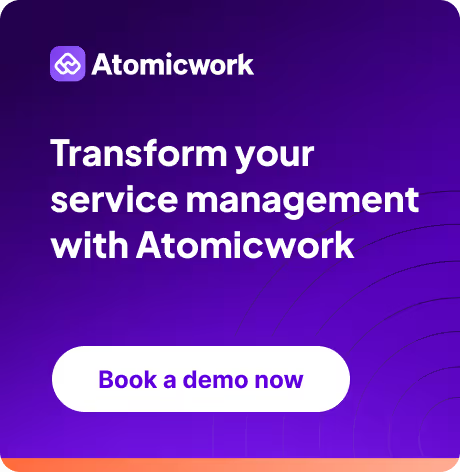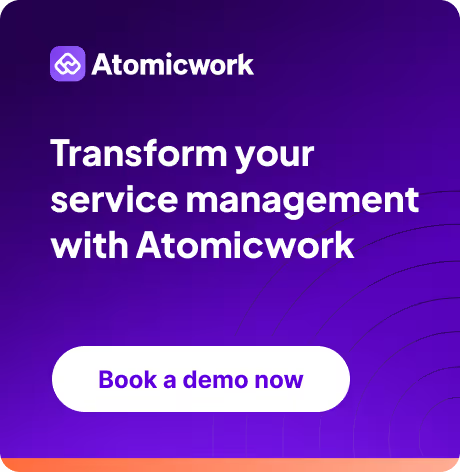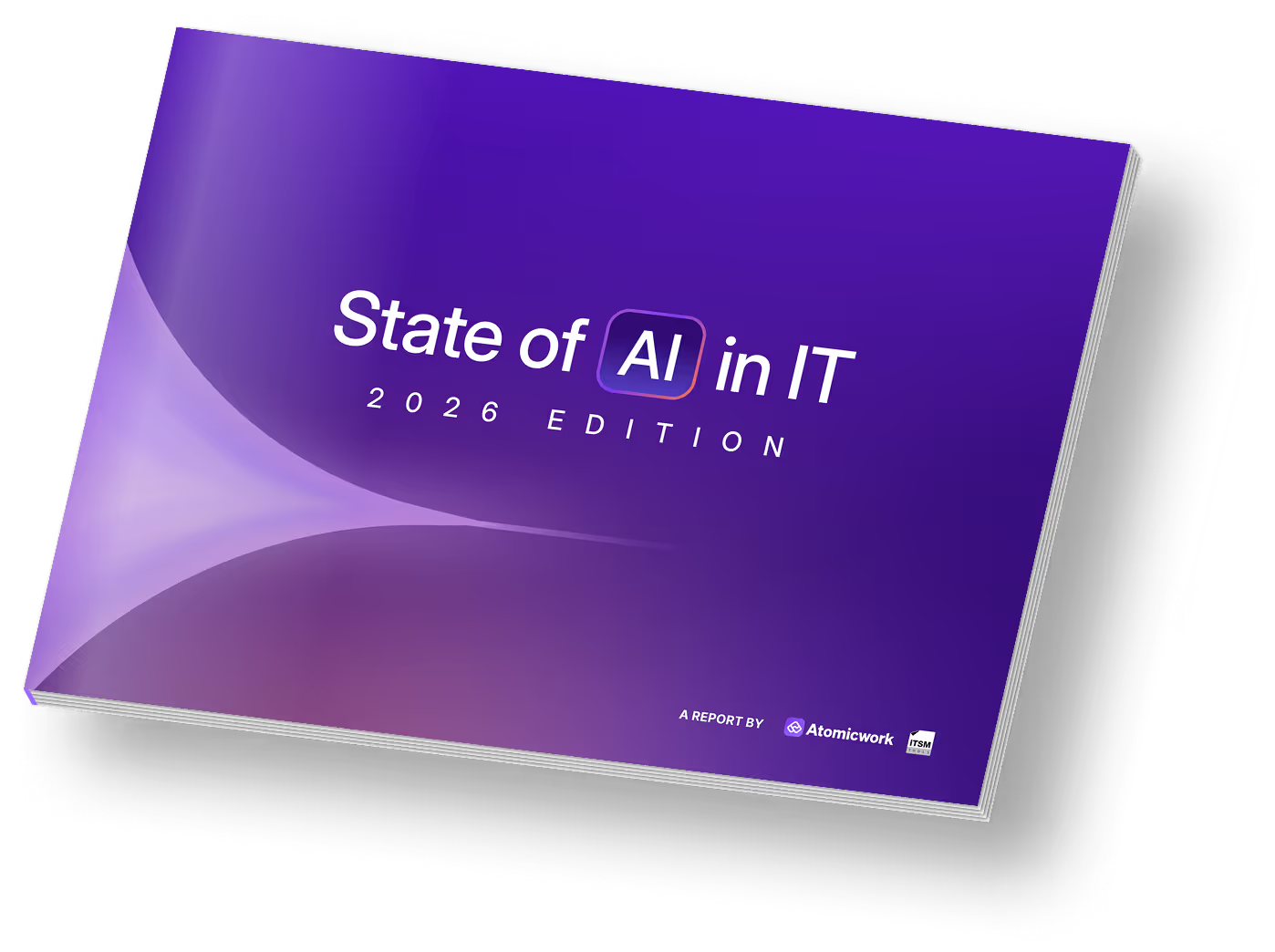How Vidyard integrates culture, scales transparency, and harnesses technology

“Employees are a company’s most valuable asset. When organizations align their business and people strategies, they become primed for rapid growth,” reads Sarika Lamont’s LinkedIn profile description.
We knew right off the bat that our philosophy about work at Atomicwork were perfectly in line with hers. We promptly wrote to the Vice President and Head of People and Culture at Vidyard, and asked if she would be interested in a conversation about building and scaling culture, leveraging technology in HR, the right approach to making HR tech decisions, and AI's impact on people functions, among other things.
She warmly agreed, and we caught up on a fine Friday morning. And we're excited to finally be able to share all the wisdom nuggets we collected from the conversation.
To those who need a bit more context about Sarika and Vidyard, here you go. For the others, jump right to the next section.
Vidyard, a company headquartered in Kitchener, Ontario, is an asynchronous Go To Market platform that drives the exchange of value between buyers and sellers through its video-based products. Over 12 million people and 160,000+ companies use Vidyard to create and share videos. The company has a workforce of over 300 people.
Sarika Lamont plays a crucial role in shaping the employee experience at Vidyard. With over 18 years of experience in consulting, talent, and organizational transformation, Sarika is also an Expert Contributor for the Forbes Human Resources Council and a Founding Member of Hacking HR's Experts Council. It's safe to say that Sarika's commitment to creating positive and engaging workplaces is evident through her extensive experience and involvement in the field.
Immersing candidates in company culture even before day one
We've always prioritized the candidate experience at Vidyard. And given right now, with so many people looking for jobs on the market, on the heels of so many layoffs in the tech industry, it's become that much more important that we treat these candidates with incredible amounts of empathy, and humanize the recruitment and onboarding processes.
It's important that a candidate has someone in talent acquisition that they can talk to at any point in time. When we send out our first email, we embed a short video from the recruiter, saying something along the lines of "Hi, I'm Sarika! I'm going to be your recruiter on this journey. Here's what you can expect. Here's the layout. Feel free to reach out to me if you need anything"
A gesture as simple as this makes the process that much more human, and gives the candidate a person whom they can actually connect with.
We design our processes in a way to ensure that our Say:Do ratio is always high; that what we say and what we do are one.
This means setting up regular touchpoints throughout the interview and onboarding process. Following up with candidates to ensure they always know where they stand. And when we do have to reject a candidate, doing so with an incredible amount of empathy.
We put ample thought into our rejection emails. Instead of a templatized "We're sorry you weren't a good fit, good luck with your job search," message, we share a list of resources that could help the candidate as they look for their next opportunity, a three-month free code to use Vidyard, and a guide to how they can use our product to make their job search more effective.
We try our best to provide as much feedback, guidance, and resources to help the rejected candidate. To me, it's about building a long-term connection.
Just because someone isn't a fit for your company right now, doesn't mean that they'll never be a fit for your company.

Integrating people into the culture - synchronously and asynchronously
There's a delicate balance between hiring for culture and hiring a diverse workforce. Hiring for culture sometimes gets misconstrued as hiring the same kind of person.
And we're mindful of that at Vidyard.
Granted, there's a specific set of skills and competencies we look for in candidates, that align with our values. But the predominant way we infuse our culture into the hiring and onboarding process is through the candidates' experience.
Whether you're a fledgling startup or a scaling organization, how you treat someone in onboarding is really important.
Let's say a new hire gets a sign-off letter, is super excited about their job, and doesn't start for two weeks. And they don't hear from the company till the day before they're supposed to start. That's a missed opportunity. You have to anticipate what the new hire must be going through and design experiences around that.
You need to root every single part of the process around people, whether they're a potential candidate, a rejected applicant, or a new hire.
At Vidyard, one of the main ways we integrate new hires into the culture is through our virtual live onboarding sessions.
So there's an asynchronous component and a synchronous component of our onboarding. The asynchronous component is taken care of using our HRIS system, where we automate several touchpoints along the journey. Every few days, the new hire gets a note from us on what to expect at the end of every week for the first four weeks, and the first 30, 60, and 90 days. We do the same thing for our managers who are onboarding people so that everyone has a consistent experience, and they're all getting integrated and getting the same type of information.
On the synchronous side of the process, we have our live onboarding sessions, where the new hires hear from the leaders. And we've designed the content of the live experience around what is important for a new employee to know.
What our values are. What they mean in day-to-day actions and decisions.
How we connect, collaborate, and communicate in our remote-first setting. How to navigate our Confluence page. How to use our Slack channels.
How Vidyard started. What our product does. Who the team is. What their benefits are.
Finally, we point them in the direction of their business partner, who will then have more detailed and deeper conversations with the new hire.
In essence, we make sure that right from the very beginning, people are clear about what we believe in, how we operate, where to find information, and how to immediately connect and find community within the organization.

Managing communication and transparency at scale
How you operate and communicate will keep changing as you scale your organization.
When you are a 25-person startup, everybody needs to know everything, because it is likely that people are wearing a lot of different hats, and it's necessary for everybody to be on the same page.
But as you scale and grow, your company strategy evolves, and communication can become more complex. You'll have freshers, people in middle management, and senior leaders, and not everybody needs to know everything all the time. Because, in that regard, context matters.
At Vidyard, we are deliberate about when, where, and how we communicate with employees.
We are intentional about using specific Slack channels for each kind of communication. We have an 'Ask Me Anything' channel, channels for different employee resource groups, a company appreciation channel, a company announcements channel, and a channel called GrowYard, which is for all things employee talent development, and their related programs and resources.
We're also redesigning how, we, as a leadership team, communicate with our employees.
Every Tuesday, we have an hour-long Employee Stand-up session. It's asynchronous, where we produce the video upfront and employees can watch it during the session, or they can go back and watch it later. Those videos are about what's going on tactically inside the organization, what's going on in the community around us, and what's going on with our people (like employee spotlights).
Then on the first two Thursdays every month, our CEO and leadership team send out a 10-minute video that talks about all the bigger, strategic aspects of the business - how we are doing against our goals, what our challenges are, and so on. And every third Thursday, we have a live All-hands session with the CXO team, where employees have the opportunity to ask us whatever questions they have.
There's a lot of movement happening within and outside the company, and it's important that we make sure to have a consistent touchpoint with our employees across the organization.
And I believe that this is the best time to build a good system for that.
The bear market we're in right now presents a great opportunity for companies to take a step back, and actively think about their processes, programs, and systems that need to be refined/scaled.
We have ample space and time to do that right now, so when the economy eventually gets better, we're in the best position to double down and scale up.

Ensuring cross-functional alignment in HR tech decisions
I've been part of several hyper-growth companies, and I've been part of multiple mergers, acquisitions, and integrations - and I've noticed that something that always falls by the wayside in all those experiences, is the people technology decisions.
Decisions around investing in the right technology and tools that shape employee experience from an enterprise view, to be precise. When you're scaling fast, people tend to go heads-down on their own work, and teams tend to get siloed in their own spaces. And that's when different departments start making technology decisions in a vacuum.
Eventually, you have disparate systems that don't work together. And you end up having a lot heavier workflows, and a lot more work that has to get done manually.
All because you didn't think about gathering requirements from all your other stakeholders before buying new technology.
At Vidyard, we recently made a decision to bring in a new human resources information system (HRIS). As the People function, we gathered the requirements of our HR professionals to help with that decision.
But we didn't stop there. We also went to other primary stakeholders in the business. What do other leaders need from an HRIS? What do Finance and Accounting need from an HRIS? How does it work with our headcount planning and forecasting system? Are there any touchpoints between other IT systems that we need to think about? Does it work with Okta's single sign-on system? Does it integrate with Slack?
We need our systems to talk to each other and scale with us as we grow. So we are particular about implementing well-connected systems, that can help us create automated workflows.
This not only brings efficiency to the operational components of the business, but it also brings efficiency to the people that are actually using the systems.
So our strategy is to break down silos between functions and keep improving our cross-functional collaboration and alignment.

Focusing on employee/end-user experience of HR technology
When it comes to digital transformation, I see companies generally trying to retrofit their processes around the technology, versus starting with the processes they have in place and the experience they desire, and then overlaying the technology on top of that. And because of that, their technology decisions get farther removed from what the end user needs.
Don't design the experience to fit the technology. Design the process and experience you want, and then try to align your technology with those needs.
Consistent and active listening exercises with your employees are important. That's the best way for you, as a People leader, to get a real understanding of the employee experience.
I do a lot of skip-level meetings. I regularly connect with people that I don't normally cross paths with in the organization. We do different kinds of pulse surveys and engagement surveys, focus groups, and one-on-ones with managers, from which I get a lot of context on what people desire, what's working, what's not working, how they get information, how they connect, and how are they growing their careers.
And that gives me a good grasp of what I have to pay attention to in terms of employee experience, when I think about overlaying technology.
For my team, the end user is the employee. So just like how our customer-facing teams and product teams are constantly talking to Vidyard's users to get a better understanding of how our product can help them, the People function does the same thing, internally.
I'm very clear that I want to acquire technology that makes sense for the employee because, at the end of the day, they are the ones who'll be using the solution. So we make sure that we have a transparent conversation with employees and letting them know that this is what we're setting out to do, and this is what we need their feedback for so we can design the experience accordingly.
Once we implement a new technology, we start tracking usage metrics. How was the utilization? How was the adoption? We check whether there's a utilization and adoption drop in specific groups, specific functions, specific teams, etc., so we can zero in on having conversations with those people and bringing them along.

Weighing in on AI and the future of HR technology
I can see that the newer HR tech systems are increasingly being designed with the employee experience in mind. And I'm really happy to see this shift.
Consider the larger, big-box HRIS and ERP systems of the industry. They're so heavy with a lot of established processes and workflows, that it would be very hard for them to adapt to an end-user's specific needs and requirements.
The newer systems, on the other hand, are laser-focused on just a couple of things, and try to be really good at a few elements rather than trying to do everything under the sun an HR function would need. And their user experience (UX) and user interface (UI) are very much directed towards the needs of the employees, rather than the administrators.
What I do think we're going to see more of in the next year, or at least I hope is, AI automating processes, bringing more efficiency, and taking the guesswork out of people-related decisions.
I would love to see AI being leveraged a lot more on the data and analytics components of HR tech. I think it's something that People teams have always struggled with - we have this data now, but how do we analyze this data, find the right insights, and take action on those insights?
For example, AI can perform sentiment analyses, look at data from engagement surveys, identify trends, and recommend actions based on those trends.
AI could also bring a lot of value in performance reviews. They can analyze an employee's career framework, feedback, review information, and suggest relevant areas of improvement. They can enable managers to have impactful performance conversations with their employees, with effective guidance, coaching, and mentorship. I'd love to see that happen.
From a People leader's perspective, I think AI is going to automate many redundant tasks and communications (like answering frequently asked questions from employees, for example), that generally take up a lot of my HR team's time.
It's going to free up the time that HR teams spend on redundant, low-impact tasks. So they can then leverage that time to be more empathetic, more human in their processes and interactions with employees.
It's going to allow us to be more strategic in the way we approach people, their experiences, and the business. That's the beauty of AI.
I know, there's so much fear out there that robots are taking over the world. But it doesn't have to be that way.
I believe AI is going to take over tasks that we didn't even want to do in the first place. And in turn, it will give us more time to do the things that we'd love to do more of.
It's going to enable companies to have better connections with their employees, while also driving higher engagement, higher productivity, and the ability to upskill employees faster.
Frequently asked questions

Faq answer paragraph

Faq answer paragraph

Faq answer paragraph

Faq answer paragraph

Faq answer paragraph

Faq answer paragraph

Faq answer paragraph

Faq answer paragraph

Faq answer paragraph

Faq answer paragraph
You may also like...


































